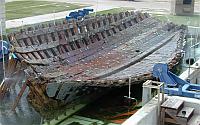
Photo: AP Photo/Texas A&M University
When the Swedish warship Vasa was raised from the seabed in 1961, to prevent her her waterlogged timbers from shrinking and cracking, the hull was sprayed, inside and out, continuously with polyethylene glycol for 17 years, followed by 9 years of slow drying. The British carrack Mary Rose has undergone a similar treatment.
Now, archaeologists at the Texas A&M University Center for Maritime Archaeology and Conservation are trying a new approach in preserving La Belle, a French ship built in 1684, which sank two years later in a storm on Matagorda Bay, about midway between Galveston and Corpus Christi, Texas. Rather than using the lengthy and costly process of displacing the water in the ship’s timbers with polyethylene glycol, the Texas researchers will attempt to freeze-dry the hull. La Belle was one of Robert de La Salle’s four ships when he explored the Gulf of Mexico.
French shipwreck to be rebuilt after freeze drying process A French explorer’s ship that sank in the Gulf of Mexico in the 17th century is to be rebuilt after undergoing a complex freeze drying operation, the first such undertaking of its size.
By placing the ship – La Belle – in a constant environment of up to 60 degrees below zero, more than 300 years of moisture will be safely removed from hundreds of European oak and pine timbers and planks.
The freeze-dryer, located at the old Bryan Air Force base several miles northwest of College Station, is 40 feet long and 8 feet wide – the biggest such machine on the continent devoted to archaeology.
Researchers will then rebuild the 54 ½-foot vessel, which will become the centrepiece of the Bob Bullock Texas State History Museum in Austin.
